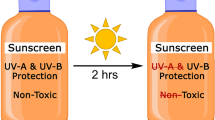Abstract
Exposure to ultraviolet (UV) light impairs the function of inflammatory cells. Urocanic acid (UCA) in an stratum corneum has been suggested as a mediator in the immunosuppression of lymphoid cells detected after irradiation with UVB (UV wavelengths 280–320 nm). In this study, we examined the effects of the two UCA isomers,trans andcis UCA on human polymorphonuclear leukocytes, neutrophils. It was found that treatment of cells with eithertrans ofcis UCA isomers inhibited the opsonized zymosan-induced respiratory burst activity, measured with luminolenhanced chemiluminescence assay. Both isomers were also able to partially block the up-regulation of complement receptors 1 (CR1; CD35) and 3 (CR3; CD11b/CD18) in N-formyl-methionyl-leucyl-phenylalanine (FMLP)-stimulated neutrophils. These results indicate that the isomerization oftrans UCA toeis UCA is not essential for the action of UCA on neutrophils. Neither of the UCA isomers were found to induce cyclic AMP (cAMP) formation in 3-isobutyl-1-methylxanthine treated cells, suggesting that the activation of adenylate cyclase-cAMP system is not involved in UCA provoked suppression of neutrophils. It is concluded that the function of UCA may be protective, to suppress the activation of human neutrophils in inflamed, sunburned epidermis.
Similar content being viewed by others
References
Streilein, J. W. 1993. Sunlight and skin-associated lymphoid tissues (SALT): If UVB is the trigger and TNFα is its mediator, what is the message.J. Invest. Dermatol. 100:47S-52S.
Noonan, F. P., andE. C. De Fabo. 1992. Immunosuppression by ultraviolet B radiation: initiation by urocanic acid.Immunol. Today 13:250–254.
Tabachnick, J. 1957. Urocanic acid, the major acid soluble, UV-absorbing compound in guinea pig epidermis.Arch. Biochem. Biophys. 70:295–298.
Baden, H. P., andM. A. Pathak. 1967. The metabolism and function of urocanic acid in skin.J. Invest. Dermatol. 48:11–17.
Spier, H. W., andG. Pascher. 1959. Die wasserlöslichen Bestandteile der peripheren Hornschicht (Hautoberfläche).Quantitative Analysen Arch. Klim. Exp. Dermatol. 209:181–183.
Norval, M., T. J. Simpson, E. Bardshiri, andJ. Crosby. 1989. Quantification of urocanic acid isomers in human stratum corneum.Photodermatol. 6:142–145.
De Fabo, E. C., andF. P. Noonan. 1983. Mechanism of immune suppression by ultraviolet irradiation in vivo. I. Evidence for the existence of a unique photoreceptor in skin and its role in photoimmunology.J. Exp. Med. 157:84–98.
Anglin, J. H., A. T. Bever, M. A. Everett, andJ. H. Lamb. 1961. Ultraviolet-light-induced alterations in urocanic acid in vivo.Biochem. Biophys. Acta 53:408–409.
Harriot-Smith, T. G., andW. J. Halliday. 1988. Suppression of contact hypersensitivity by short term ultraviolet irradiation. II. The role of urocanic acid.Clin. Exp. Immunol. 72:174–177.
Ross, J. A., S. E. M. Howie, M. Norval, J. Maingay, andT. Simpson. 1986. Ultraviolet irradiated urocanic acid suppresses delayed-type hypersensitivity to Herpes simplex virus in mice.J. Invest. Dermatol. 87:630–633.
Noonan, F. P., E. C. De Fabo, andH. Morrison. 1988. Cis-urocanic acid, a product formed by ultraviolet B irradiation of the skin, initiates an antigen penetration defect in splenic dendritic cells in vivo.J. Invest. Dermatol. 90:92–99.
Räsänen, L., C. T. Jansen T. Reunala andH. Morrison. 1987. Stereospecific inhibition of human epidermal cell interleukin-1 secretion and HLA-DR expression by cis-urocanic acidPhotodermatol. 4:182–186.
Gilmour, J. W., J. P. Vestey, S. George, andM. Norval. 1993. Effect of phototherapy and urocanic acid isomers on natural killer cell function.J. Invest. Dermatol. 103:169–174.
Uksila, J., J. K. Laihia, andC. T. Jansen. 1994. Trans-urocanic acid, a natural epidermal constituent, inhibits human natural killer cell activity in vivo.Exp. Dermatol. 3:61–64.
Hawk, J. L. M., G. M. Murphy, andC. A. Holden. 1988. The presence of neutrophils in human cutaneous ultraviolet-B inflammation.Br. J. Dermatol. 118:27–30.
Cooper, K. D., N. Duraiswamy, C. Hammerberg, E. Allen, C. Kimbrough-Green, W. Dillon, andD. Thomas. 1993. Neutrophils, differentiated macrophages and monocyte/macrophage antigen presenting cells infiltrate murine epidermis after UV injury.J. Invest. Dermatol. 101:155–163.
Csato, M., K. Jablonski andH. Tronnier. 1984. Effect of ultraviolet radiation on granulocyte chemotaxis and nitroblue tetrazolium reduction activity in healthy individuals.Br. J. Dermatol. 111:567–570.
Lundin, Å., G. Michaelsson, P. Venge, andB. Berne. 1990. Effect of UVB treatment on neutrophil function in psoriatic patients and healthy subjects.Acta Derm. Venereol. (Stockh).70:39–45.
Laihia, J. K., andC. T. Jansen. 1994. Urocanic acid photoconversion in relation to erythematogenicity of radiation from different types of phototherapy equipment.Photodermatol. Photoimmunol. Photomed. 10:13–16.
Leino, L., J. Nuutila, T. T. Pelliniemi, andA. Rajamäki. 1993. Human recombinant GM-CSF selectively primes receptor mediated respiratory burst of neutrophils in vitro.Immunology Lett. 38:26–31.
Leino, L., andE. M. Lilius. 1992. The up-and down-modulation of immunoglobulin G Fc receptors and complement receptors on activated human neutrophils depends on the nature of activator.J. Leukoc. Biol. 51:157–163.
Harper, J. F., andG. Brooker. 1975. Femtomole sensitive radioimmunoassay for cyclic AMP and cyclic GMP after 2'O acetylation by acetic acid anhydride in aqueous solution.J. Cyclic Nucleotide Res. 1:207–218.
Brooker, G., J. F. Harper, W. L. Terasaki, andR. D. Moylan. 1979. Radioimmunoassay for cyclic AMP and cyclic GMP.Adv. Cyclic Nucleotide Res. 10:1–33.
Laihia, J. K., C. T. Jansen, J. Uksila, J. Punnonen, K. Neuvonen, P. Pasanen, andP. Åyräs. 1994. Effects of cis- and trans-urocanic acids on the secretion of interleukin-1β and tumor necrosis factor-α by human peripheral blood monocytes.Acta Derm. Venereol. (Stockh).74:266–270.
Palaszynski, E. W., F. P. Noonan, andE. C. De Fabo. 1992. Cis-urocanic acid down-regulates the induction of adenosine 3′,5′-cyclic monophosphate by either trans-urocanic or histamine in human dermal fibroblasts in vitro.Photochem. Photobiol. 55:165–171.
Leino, L. andE. M. Lilius. 1990. Histamine receptors on leukocytes are expressed differently in vitro and ex vivo.Int. Arch. Allergy Appl. Immunol. 91:30–35.
Derian C. K., R. J. Santulli, P. E. Rao, H. F. Solomon, andJ. A. Barrett. 1995. Inhibition of chemotactic peptide-induced neutrophil adhesion to vascular endothelium by cAMP modulators.J. Immunol. 1995;154:308–317.
Laihia, J. 1994. Urocanic Acid Biological Reflections from the Ultraviolet Switch. Turku, Annales Universitatis Turkuensis, p. 36.
Pasanen P., T. Reunala, C. T. Jansen, L. Räsänen, K. Neuvonen, andP. Ayräs. 1990. Urocanic acid isomers in epidermal samples and suction blister fluid of nonirradiated and UV-Birradiated human skin.Photodermatol. Photoimmunol. Photomed. 7:40–42.
Author information
Authors and Affiliations
Rights and permissions
About this article
Cite this article
Kivistö, K., Punnonen, K., Toppari, J. et al. Urocanic acid suppresses the activation of human neutrophils in vitro. Inflammation 20, 451–459 (1996). https://doi.org/10.1007/BF01487038
Issue Date:
DOI: https://doi.org/10.1007/BF01487038




